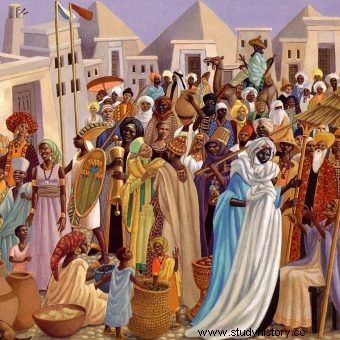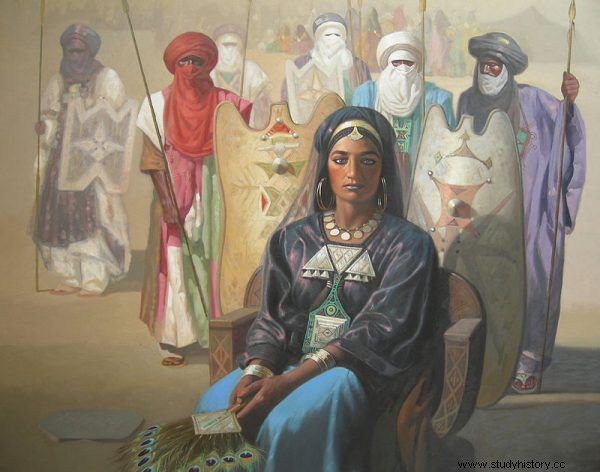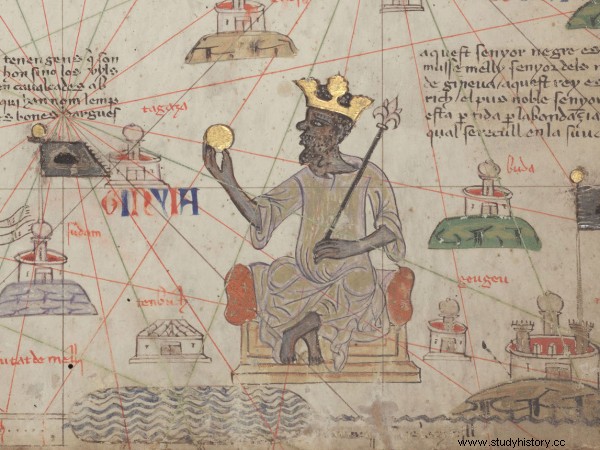Sidewalks and houses covered with pure gold. Such legends circulated about a city founded by a people who got rich by selling their compatriots into slavery. Did the African Eldorado Really Exist? If so, what led to its downfall?
At the turn of the 11th and 12th centuries, the Tuaregs - the people of the desert, living freely in the vast areas of the Sahara, in the areas of today's Algeria, Niger and Mali - founded a settlement called Timbuktu. The place was not accidental. They chose a location where the routes leading in the four directions of Africa intersected:from north to south, and from east to west, and vice versa. As Charlie English writes in his latest historical report " Smugglers of books from Timbuktu ", It was also" the intersection of the largest hot desert in the world and the longest river in West Africa ".

The legends of the African Eldorado did not leave Europeans alone. Especially the one about gold-plated sidewalks…
A settlement on the southern edge of the Sahara, a few kilometers from the main riverbed of the Niger River, became a home to Tuarean warriors and their slaves, hunters, free fishermen and farmers.
The exchange of goods flourished here. This is what the seventeenth-century chronicler Es-Sadi wrote about her:
Initially, land and river travelers met there. They had a storehouse of their goods and grains there. This place quickly became a destination for travelers who returned there more and more often. They entrusted their goods to the care of a slave, who was called Timbuktu. This word means "old" in their language, and this blessed place got its name from him .
Contemporary researchers, however, believe that the name comes from the Berber words "tim" and "buktu", which meant "place of a small dune" and was associated with the city's location on a small hill.

For centuries, Timbuktu has been the center of intense trade between Black Africa and Islamic North Africa, and through it and with Europe. Due to the wealth and relative inaccessibility, the mythical image of the city became popular.
Specialized people in human trafficking
In Timbuktu, salt, metalwork, ornaments, horses, dates, ivory, gold, leathers, perfumes, and slaves were sold and bought. The Tuaregs brought these materials from the Mediterranean, from the Maghreb countries. The other way was gold mined in the depths of Black Africa, bones and skins from animals hunted there, and captured slaves, which the Tuaregs dealt with professionally. They already traded with the Romans, and in later times took an active part in their export to the United States . Catching people was one of the main sources of income for the people of Timbuktu.
Caravans of hundreds of camels traveled to the center, river ships brought tons of goods; Here African, Berber, Arab and desert nomads met here for trade. So here Arab Africa met with Black Africa. Thanks to trade, the settlement grew rapidly and grew rich, transforming over time into a city.
At the beginning of the 14th century, Timbuktu became part of the powerful state of Mali, and shortly thereafter came its golden age. The Muslim king of Mali Musa I built there his palace and the great Jinguereber mosque with a characteristic high minaret. The city quickly became the residence of the local government representative, the provincial capital and the seat of a military garrison. At the same time, one of the main centers of the medieval empire, famous for the wealth and generosity of its rulers. A city of trade, craft and security
The flourishing city attracted people. It was inhabited by Berbers, black visitors from the center of Mali, merchants from the Maghreb, Saharan oases and even Egypt. While they organized the trade, Muslim lawyers were upholding the strict rules of trade.
The state of Mali, of which Timbuktu became a part, guaranteed stability and security. The rulers there kept the roads quiet and liquidated the robberies so effectively that - as one of the travelers wrote - it was possible to travel around the empire without escort. The judgments issued by judges (the so-called kadi) were carried out efficiently, and the abuses of local authorities were punished quickly and severely. Over time, a layer of artisans appeared, producing products for the inhabitants, local farmers and for export. Timbuktu has developed demographically and economically.
Mythical or real El Dorado?
The 15th century brought some worsening of Timbuktu's situation. First, it was captured by the Tuaregs who recaptured it from the rulers of Mali. However, they did not interfere too much in its development. It was even worse when the people defeated Sunni Ali, the ruler of a large country in West Africa called Songhaj. He persecuted the inhabitants and brought tribute from the city. The situation returned to normal only after the king's death and the end of the legacy struggles.

The principle of matriarchy was in force among the Tuaregs, the founders of Timbuktu. Illustrated is the ancient queen of a people who spent thousands of years capturing slaves and trading them with Europeans.
Thanks to this, in the 16th century the city reached its peak of development again. As estimated by the researchers, in this century in Timbuktu and the neighboring towns, could have been inhabited by as many as 35,000 people (often another, much larger number is also given - 100,000). At that time, only Gdańsk had more inhabitants in Poland. This is the description of the city, made by the traveler Leon African, in his latest historical report " Smugglers of books from Timbuktu ”Charlie English:
According to Leon Timbuktu's description, it was a rich and charming city. Although the houses there were mostly thatched mud huts, in the center of the city was "a temple of hewn stones bonded with limestone, built by an architect from Beticos [the mountains in southern Spain] ... and by the same master mason erected a great palace where the king stops."
The townspeople enjoyed "great wealth," Leon noted, and used pure gold instead of minted coins. In addition to maintaining a standing army of 3,000 horsemen and a large number of foot soldiers who fired poisoned arrows, King Timbuktu also had "a great treasure in coins and gold bars" - one of them weighed almost 600 kilograms .
Indeed, in large transactions and in long-distance trade, coins were not used, but gold weighted in the so-called mitkals, or the Arabic measure of 4.72 grams. It is estimated that in the 14th century Timbuktu was the richest city in the world.

When Timbuktu entered the Mali empire, ruled by Mansa Musa, it became a true African Eldorado. His power was based on trade, and the Muslim ruler himself allegedly accumulated a fortune worth $ 400 billion today ...
There were legends about his treasures. It was said that the sidewalks were covered with pure gold, and its rulers were full of luxuries:expensive fabrics, valuables, thoroughbred horses and slaves . Demand for gold and its high price had lingered in Mediterranean countries for centuries, and Timbuktu's gold traders were earning more and more.
How great was the wealth of this African city can be proved by the message of one of the fourteenth-century travelers - Ibn Battuta. Namely, he wrote that the ruler of Timbuktu - the aforementioned Musa I - in 1324 made a pilgrimage to Mecca in a retinue consisting of 60,000 soldiers and 5,000 slaves. The Muslim king reportedly took a ton of gold with him for… minor expenses. During the trip, however, he spent so much that he lowered the value of gold in Cairo for a whole generation causing inflation of around twelve years!
Reach Timbuktu!
The previously quoted 16th-century work of the traveler and geographer Leon entitled Describing Africa has been translated from Italian into many languages, incl. into English and quickly sparked a wave of interest in Africa and Timbuktu itself throughout Europe.
Rumors about the city's existence had been circulating in Europe for several hundred years, and its riches had been trumpeted at least since the 14th century. While Cipangu Marco Polo would be a land in which the roof of the royal palace is decorated with precious metals, houses in Timbuktu were supposedly covered with gold. Dozens of explorers were sent on a mission to find the city - Charlie English writes in " The book smugglers of Timbuktu ”.
The first European to reach the city was the British officer Alexander Gordon Laing. He arrived there in 1826, but he paid for it with his life, killed by the Tuareg. The one who managed to find the city and return was the Frenchman René-Auguste Caillié. Timbuktu's gradual decline had started earlier, however, mainly due to the expansion of maritime trade by the Portuguese and Dutch. It made it unprofitable to transport goods by road through the inhospitable Sahara. The literal nail in the coffin of prosperity Timbuktu, on the other hand, has become a Moroccan invasion.
End of size
In the second half of the 16th century, the Sultan of Morocco, Ahmed El-Mansur, began the campaign of conquest and expansion of his country. His troops moved south, occupying more areas, and in December 1591 they entered Timbuktu.
The city was plundered and repressions fell on its inhabitants. Great sums were sent to Morocco. According to the chronicles, the sultan received 100,000 mittals of gold, many slaves and other valuables . The city, which was constantly plundered, fell into decline. Riots and internal fights broke out. “It was not a heyday, there was neither a good harvest nor food. The only thing that was completely lacking was the abuse of power "- wrote the chronicler.

The Tuaregs could not bear any authority over themselves. That is why they continued to stir up new uprisings. In 2015, they were defeated by Islamic fundamentalists. The photo shows jihadists from Al-Qaeda of the Islamic Maghreb near Timbuktu.
In 1893, Timbuktu was occupied by France, and two years later incorporated into French Sudan. The era of French domination had begun. At that time, the famous African Eldorado was just a small provincial town, a shadow of a great metropolis from centuries ago.
Book smugglers
French Sudan gained independence in 1960 and took the name of the Republic of Mali. The years of independence were not peaceful, because the rebellious Tuareg, who did not bear any power over themselves, from time to time sparked another uprising against the central government. However, the worst came from the 21st century.
In 2015, the north of the country was occupied by Islamic fundamentalists, and they made Timbuktu their capital of their country. They began to destroy monuments and books. They announced that not a single old building would remain in the city. The inhabitants, tied to their history, decided to secretly take the historic manuscripts out of the city.
In addition to the enormous wealth that Timbuktu accumulated in the Middle Ages, it was also a city unusual in terms of intellectual achievements. It was here that the so-called hives. They opened schools and welcomed students known as tables. The books needed to study were imported from Cairo, Mecca, Fez and other important centers of Muslim culture. Large and valuable libraries were created in schools, at mosques, and at private homes. They were said to have a total of 700,000 to 1 million volumes .

The abundance of manuscripts in Timbuktu (pictured) exceeded all expectations. Had it not been for some of the extraordinary librarians who saved them from jihadists, the remarkable legacy of civilization would have perished.
Graduating from higher education in Timbuktu allowed for easy study in Cairo, Alexandria, Fez and Marrakesh, where students most often went. Almost all of the prominent hives of Timbuktu have completed their studies in one of these cities. The abundance of gold accumulated by local schools allowed them to pay for these costly trips, wrote the Polish historian and researcher of African history, Michał Tymowski.
Manuscripts in which the Timbuktu civilization was written, began to be smuggled after the occupation of the country by jihadists, incl. in metal boxes for vegetables and fruits. Until in January 2016 the French and government troops recaptured the city - as Charlie English reports in his historical report " Smugglers of books from Timbuktu ”- Within three months, 285,000 manuscripts were released in 2,400 boxes. They were hidden in private apartments in the country's capital Bamako, saving Timbuktu's history from oblivion.
Bibliography:
- Henry Barth, Travels and discoveries in North and Central Africa , Harper &Brothers 1859.
- Charlie English, Book smugglers from Timbuktu , 2018 Poznań Publishing House.
- Marta Kowalska, The legendary Timbuktu:The city of clay that hides priceless manuscripts , Podróże.Gazeta.pl [online access:March 15, 2018].
- Michał Tymowski, History of Timbuktu , Ossolineum 1979.
